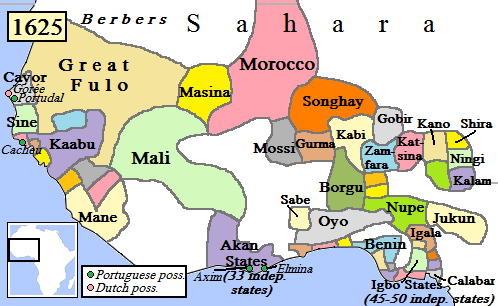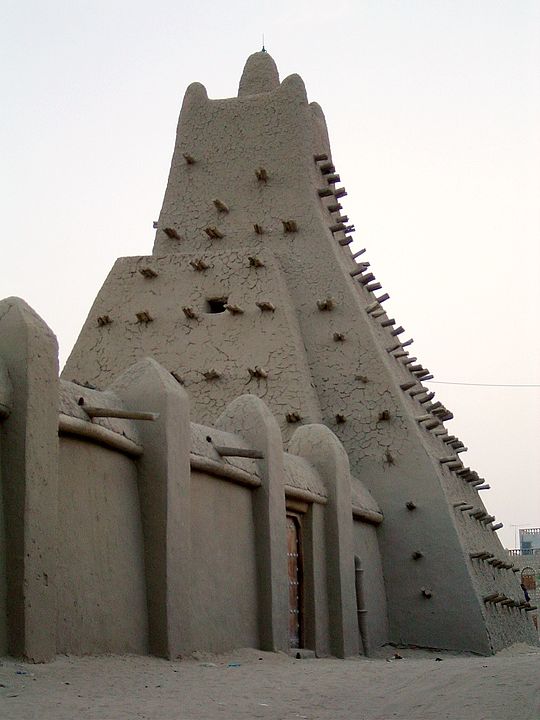Songhai Empire
Once, a man called Sunni Ali, who was part of the Sunni dynasty, took control of the city of Gao and took control of all the towns and cities in the area.
He created one of the biggest and richest empires in all of Africa.
Before him, the Empire of Mali had been in control, but Sunni Ali made sure that Songhai became even richer.
The Songhai Empire controlled all the land and trade in the 1500s and 1600s in the area south of the Sahara, called the Sahel.
At its greatest, the Songhai Empire stretched all the way from the Atlantic Ocean, across the modern-day country of Mali and east into the countries now called Nigeria and Burkina Faso.
Small beginnings: fishermen on the Niger River
Before the Empire began, there were small settlements along the Niger River. The Sorko people lived in some of these settlements.
They built fine wooden canoes and fished and hunted in their boats. They also provided water and goods up and down the river.
They traded with other peoples who lived along the River, like the Gow people, who were hunters, and the Do people, who were farmers.
The Songhai were horse riding peoples who dominated these settlements. Eventually, the Songhai took control and all these people started to speak the same language.
An ancient cemetery tells us more…
There is some evidence on local tombstones in a cemetery called Saney near Gao. Some inscriptions on the cemetery tell us about ancient kings from before the Empire of Songhai.
These kings had the title Malik and ruled in the eleventh and twelfth century AD. These kings were allowed to rule Gao and the area, even though at this time it was under the overall control of the Empire of Mali.
The city of Gao grew huge because of all the trade across the Sahara. Eventually, this became an important city in the Empire of Mali.
When the Empire of Mali started to decline and become less powerful, a Songhai king decided he should take over.
Hero or villain? Sunni Ali
Sunni Ali was the first King of the Songhai Empire. He ruled between 1464 and 1492. In 1468, Sunni Ali was given a great opportunity to grow his empire.
He was a fierce military leader. So, in 1468 when Muslim leaders asked him to drive out invaders and take over Timbuktu, he didn’t just drive out these invaders but took the city of Timbuktu for himself.
He went on to capture the thriving city of Djenne (or Jenne). To some, Sunni Ali was a hero because he was a fearless conqueror who took over all the cities of Ancient Mali and united a great empire with lots of riches.
Al Sa-df, a historian, said that Sunni Ali was a tyrant. He said he brought 1000 camels to Timbuktu to drive out the people. Al Sa-df wrote that he slaughtered and humiliated those that remained.
This is all described in ancient book, or chronicle, written in Arabic. The book is called the Tarikh-al Sudan and this is where we get a lot of our information about the Empire of Songhai.
We are not quite sure whether Sunni Ali was a hero or a villain, because there are different accounts about him that say different things.
He was probably somewhere between the two. His successor, Askia the Great, received only glowing reports about his rule!
Askia the Great was described as a hero in the Tarikh al-Sudan. According to the same historian, Al Sa-di, Askia the great was great because he had a proper professional army (like the Romans did) and he introduced lots of fair laws.
Askia the Great was noted for being a good Muslim which is perhaps why Al Sa-di (who was also a Muslim) wrote such nice things about him.
Askia ruled between 1443 and 1538. Just like Mansa Musa of Ancient Mali, Askia completed one of the five pillars of Islam, the Haaj to Mecca.
The Haaj is like a pilgrimage, or a special religious journey. Mecca is an important place for Muslims to visit.
Millions of Muslims make this pilgrimage to this day, just like Mansa Musa of Ancient Mali and Askia the Great of Songhai.
The pilgrimage
Askia took lots of gold with him on his Haaj. He gave lots to charity and used the rest as gifts.
He brought lots of things back to the Songhai Empire on his return. One of the things he brought back was learning!
He brought in scholars from Morocco and Egypt to work in the Sankore mosque in the city of Timbuktu. He set up many learning centres throughout his Empire.
He also set up observatories in the capital because he loved astronomy (the study of stars).
Decline
In 1528 there was a revolt and the Empire lost its power. There were lots of civil wars which meant different people within the Empire were fighting each other.
Then, in 1531, Morocco invaded Songhai unexpectedly. Songhai was very weak from all the people fighting within its borders so the Empire collapsed.
Quiz
Why did the city of Gao grow?
Who was Sunni Ali?
How many camels did Sunni Ali use to occupy Timbuktu?
Where did Askia the Great visit?
What did Askia the Great bring back from his pilgrimage?










